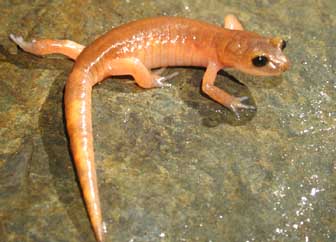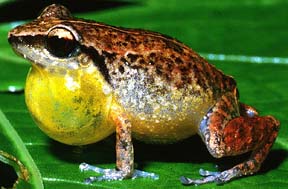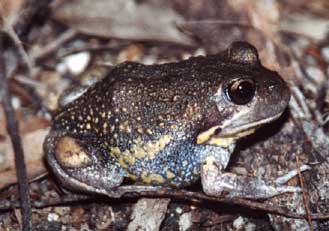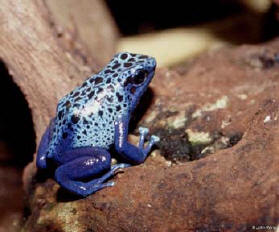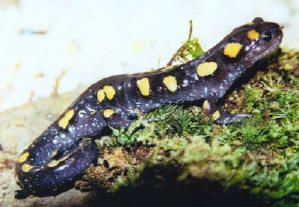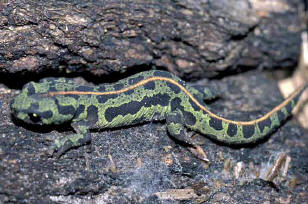|
Amphibians Around The World |
|||||||||||||||||||||||||||||||||||||||||||||||||||||||||||||||||||||||||||||||||||||||||||||||||||||||||||||||||||||||||||||||||
|
Photo by Arie van der Meijden Monterey Salamander Ensatina e. escholtzii
|
Photo by Rich Glor Abbott's Robber Frog Eleutherodactylus abbotti
|
||||||||||||||||||||||||||||||||||||||||||||||||||||||||||||||||||||||||||||||||||||||||||||||||||||||||||||||||||||||||||||||||
| Just how many species of amphibians are there in the world? Current estimates of amphibian species are approximately 5,383. This number is constantly changing though as new species are discovered, some species become extinct, and changes in classification may combine species or split one species into several different species. Here are the current numbers: |
|||||||||||||||||||||||||||||||||||||||||||||||||||||||||||||||||||||||||||||||||||||||||||||||||||||||||||||||||||||||||||||||||
Table data compiled from: AmphibiaWeb: Information on amphibian biology and conservation. [web application]. 2002. Berkeley, California: AmphibiaWeb. Available: https://amphibiaweb.org/. (Accessed: 2002).
|
|||||||||||||||||||||||||||||||||||||||||||||||||||||||||||||||||||||||||||||||||||||||||||||||||||||||||||||||||||||||||||||||||
|
Photo by Sean Schoville Eastern Banjo Frog Limnodynastes dumerilii
|
Photo by John White Blue Poison Frog Dendrobates azureus
|
||||||||||||||||||||||||||||||||||||||||||||||||||||||||||||||||||||||||||||||||||||||||||||||||||||||||||||||||||||||||||||||||
| Frog Families Of The World There are 29 families which make up the Order Anura. Ten of these families have species represented in the United States, some introduced. Five of these families have representatives in Tennessee, none introduced. Twenty one percent of the anuran species of the United States occur in Tennessee. Less than one percent of the frog species of the world occur in Tennessee, yet they are one of our most important ecological indicators. |
|||||||||||||||||||||||||||||||||||||||||||||||||||||||||||||||||||||||||||||||||||||||||||||||||||||||||||||||||||||||||||||||||
|
|||||||||||||||||||||||||||||||||||||||||||||||||||||||||||||||||||||||||||||||||||||||||||||||||||||||||||||||||||||||||||||||||
|
Table data compiled from: AmphibiaWeb: Information on amphibian biology and conservation. [web application]. 2002. Berkeley, California: AmphibiaWeb. Available: https://amphibiaweb.org/. (Accessed: 2002). Duellman, William E., 1999. Patterns of Distribution of Amphibians: A Global Perspective. The Johns Hopkins University Press, Baltimore and London. 633pp. U.S. Amphibian Distribution Maps. Laura Blackburn, Priya Nanjappa, and Michael J. Lannoo. [web application]. 2001. Available: .
|
|||||||||||||||||||||||||||||||||||||||||||||||||||||||||||||||||||||||||||||||||||||||||||||||||||||||||||||||||||||||||||||||||
|
Photo by Kyle Carter Spotted Salamander Ambystoma maculatum
|
Photo by Henk Wallays Marbled Newt Triturus marmoratus pygmaeus
|
||||||||||||||||||||||||||||||||||||||||||||||||||||||||||||||||||||||||||||||||||||||||||||||||||||||||||||||||||||||||||||||||
|
Salamander Families Of The World
There are 10 families which make up the Order Caudata. Nine of these families have species represented in the United States. Seven of these families have representatives in Tennessee. Almost thirty three percent of the salamander species in the United States occur in Tennessee. Eleven percent of the salamander species of the world occur in Tennessee. The Great Smoky Mountains National Park is known as "The Salamander Capitol of the World." |
|||||||||||||||||||||||||||||||||||||||||||||||||||||||||||||||||||||||||||||||||||||||||||||||||||||||||||||||||||||||||||||||||
|
|||||||||||||||||||||||||||||||||||||||||||||||||||||||||||||||||||||||||||||||||||||||||||||||||||||||||||||||||||||||||||||||||
|
Table data compiled from: AmphibiaWeb: Information on amphibian biology and conservation. [web application]. 2002. Berkeley, California: AmphibiaWeb. Available: https://amphibiaweb.org/. (Accessed: 2002). Duellman, William E., 1999. Patterns of Distribution of Amphibians: A Global Perspective. The Johns Hopkins University Press, Baltimore and London. 633pp. Petranka, James. 1998. Salamanders of the United States and Canada. Smithsonian Institution Press, Washington and London. 587pp. Redmond, W. H. and A. F. Scott. 1996. Atlas of Amphibians in Tennessee. Miscellaneous Publication Number 12. The Center for Field Biology, Austin Peay State University, Clarksville, TN. 94 pp. U.S. Amphibian Distribution Maps. Laura Blackburn, Priya Nanjappa, and Michael J. Lannoo. [web application]. 2001. Available: .
|
|||||||||||||||||||||||||||||||||||||||||||||||||||||||||||||||||||||||||||||||||||||||||||||||||||||||||||||||||||||||||||||||||
|
For more information about frogs and toads check out:
Introduction to the
Anura ||
Anuran
Life Cycle
List of
Scientific Frog Names ||
Amphibian Declines
The Frogs and Toads of Tennessee ||
Tennessee
Amphibian Monitoring Program
Updated August 18, 2020
|
|||||||||||||||||||||||||||||||||||||||||||||||||||||||||||||||||||||||||||||||||||||||||||||||||||||||||||||||||||||||||||||||||
